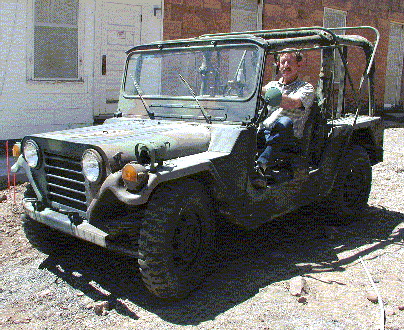
|
Vol.
12. No. 2
|
Fall
2002
|
17 Fort Douglas Military Museum
On quiet Potter Street, across from Stilwell Field in historic Fort Douglas, is a small but illuminating treasure — the Fort Douglas Military Museum. Founded in 1974, this site offers a fascinating foray into the military history of Utah and of the United States.
A little musty, as any museum of this type is wont to be, the facility is filled with treasures dating back to the earliest days of the Utah Territory. The first display one sees depicts the Nauvoo Legion — a precursor to the Mormon pioneers and the valley's first body of military defense. Little-known facts about Utah's participation in the Spanish-American War are detailed here. Nearby is a diorama of the early Camp Douglas village, with its sparse buildings and dusty roads. And around another turn is an authentic handcart used as a mode of transportation around the camp — and as a "garbage truck."
In the Navy room, entered through a transplanted ship's door, are photographs of the bombed battleship USS Utah, documenting its gradual sinking at Pearl Harbor. There is also a model of the cruiser USS Salt Lake City, with memorabilia taken from that ship.
Displays of uniforms, guns, ammunition, and decorations bring the historic conflicts to life, from the earliest days of the Nauvoo Legion through the two world wars, the Korean conflict, and Viet Nam. Honor rolls and Walls of Honor, recognizing men and women killed in these conflicts, make the history personal. The Pearl Harbor Room contains a magnificent array of modelsbattleships, cruisers, and destroyers-many of which were crafted by Merv Brewer, a member of the Salt Lake Plastic Modelers Club.
The grounds around the 1875 sandstone building also harbor museum artifacts. Art Gogan, Navy master chief and machinist mate (ret.), is the museum's armament specialist and keeps the equipment in good repair.
He points out the Sherman tank from WWII, the Sheridan tank from the end of the Korean conflict, and the Patton tank M47 M48 used after the Korean War. There is an armored personnel carrier with a rocket launcher. The imposing Cobra and Huey helicopters conjure up images of jungle rescues and rushed landings, and the Loach helicopter has meaning for those who were in reconnaissance. A dusty Jeep M151 that saw action in Viet Nam and Desert Storm sits next to the intimidating cannon field with its well-marked specimens, ranging from the Civil and Indian Wars to WWI, Korea, and Viet Nam.
Col. (Ret.) Robert S. Voyles, director of the museum, is anxious for people to know about and appreciate the museum. "Thirty to 40 percent of our visitors are veterans," he says. "And they bring their families." Many of the items displayed in the museum come from these veterans and their families. "We are now in the process of working on a major expansion of the museum," he explains. "We have so many stories to tell." He details plans for expansion of the Marge Riley Memorial Library, a valuable source for research, and for construction of a small theater where short films telling the story of the fort can be screened. There will also be a larger theater and a visitors' center that will house exhibits about the fort and a gift shop, among other things.A visitor to the museum should not fail to ask about Clem, the resident ghost, who has been seen wearing a Civil War uniform. Or come to the museum on Halloween night when the stories are told and ghostly pictures shown. You may leave having caught a glimpse of Clem.
—Nettie Bagley-Pendley BA'59 is editorial assistant for Continuum.
